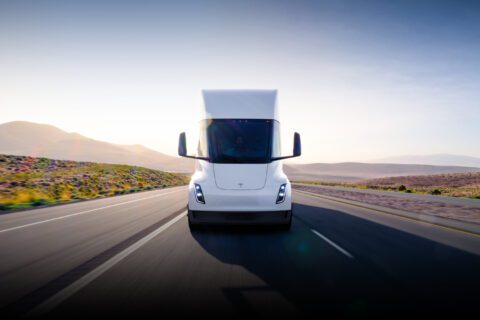Battery Breakthrough: Double Density Batteries Leave Diesel in the Dust?
Breakthrough Battery Tech Doubles Electric Truck Range: Debunking ATA’s Resistance A groundbreaking announcement from battery giant CATL is set to revolutionize the electric trucking industry, challenging the American Trucking Associations’ (ATA) claims about electric trucks. CATL, which owns 34% of global battery market share, unveiled a 500 Wh/kg battery with plans to utilize it for both aviation and automotive use. This new battery technology offers almost double the energy density of Tesla’s Panasonic batteries, which have dominated the market for years. CATL’s Game-Changing Battery The unveiling of CATL’s new battery has the potential to send ripples throughout the industry and could offer the extra needed push for a major electrification of the trucking industry. The potential of this new tech cannot be understated, to really put it in perspective, this advancement has the ability to allow the current existing model of Tesla Semi’s to reach a range of around 900 miles, a significant improvement over its already impressive 500-mile range. This is a crucial development in the electric vehicle industry, as higher energy density means longer ranges and ultimately would lead to a much more proactive and faster adoption of electric trucks. ATA’s False Claims? Recent claims made by Andrew Boyle, first vice chair of the ATA, to Congress have been been drawing attention after concerns for their accuracy were raised. For starters, he stated that current battery-electric semi trucks only have a range of between 150-330 miles, this is easily debunked given that the Tesla Semi is already delivering significantly more than this. He then went on to also overestimated the weight of the required battery packs along with the time it would take to charge them. These inaccuracies have been categorized as a downplay of the incredible advancements being made by the driven minds already dedicated to the electric trucking industry. The Real Cost of Electric Trucks Boyle’s claims didn’t stop there, claiming that battery-electric trucks would cost a staggering $300,000 more than a traditional diesel semi. However, Tesla’s projections as well as their now fulfilled semi orders indicate that the true cost is actually around $150,000 – $180,000 for the 300 and 500-mile range vehicles, respectively. While this is slightly more expensive than the current diesel offerings, with a mid-market semi costing around $150,000, the Tesla Semi additionally touts savings upwards of $200,000 over its lifetime, positioning it as a very lucrative investment for fleets. Furthermore, Boyle claimed that electric trucks couldn’t get cheaper, a claim that actively contradicts a rule of thumb known as Wright’s Law. Simply put, Wright’s Law predicts that the price of batteries for trucks will drop as battery manufacturing for transportation use cases doubles. This law has been observed in various industries, including aviation, semiconductors, and solar panels. With this in mind, there should be little doubt that as battery technology continues to improve and economies of scale are achieved, the cost of electric trucks is expected to decrease, eventually making them more affordable than diesel trucks. As an added bonus, the cost of owning an electric truck is predicted to be lower than that of a gas truck over time, as fuel and maintenance costs are lower for electric trucks. Climate Change: Ignoring the Elephant in the Room On top of that, Boyle also failed to mention climate change at all during his statements. Heavy-duty Class 8 trucks produce about 7% of the United State’s total CO2 emissions. The Phase 3 emissions standards goal for 2032 only requires a 19% efficiency gain, which the ATA has complained about. However, the proposed standards have been deemed both reasonable and achievable by industry analysts, especially with such a major development in battery technology California’s Push for Zero-Emission Trucks California’s new rules for Class 8 trucks has definitely made headlines recently, given that they are requiring all new trucks sold in the state to be zero-emission from 2040. Some believe this may be the reason behind Boyle’s misleading statements. That being said, with electric trucks like the Tesla Semi already demonstrating such impressive range capabilities, there’s really no doubt that trucking firms can start buying electric vehicles this year and gradually replace their fleets with battery electric vehicles by 2040. The Road Ahead: Overcoming Charging Infrastructure Challenges Boyle’s did express one valid concern, that being the current state of the US distribution grids for electricity, where semi trucks will need to charge. While not every remote location will have sufficient charging infrastructure, with careful thought and planning along with intelligent use of increasingly cheap batteries and targeted electric charging corridors there is no doubt that the industry can solve this issue. Before You Hit The Road… In conclusion, whether they’re ready or not, the technology is coming and the sooner trucking industry embraces the potential of electric trucks rather than resisting climate action, the more accessible solutions will become. Beyond this, electrification offers significant advantages, including reduced operating costs, which should also be recognized and promoted by organizations like the ATA. If you made it to this part of the article, we’d just like to take a moment to thank you for taking the time to read it. Be safe out there and as always, If you’re in search of CDL A, B, or warehouse positions, check out our open positions. And if you need staffing solutions for commercial driving or industrial positions, be sure to explore our offerings.



Recent Comments